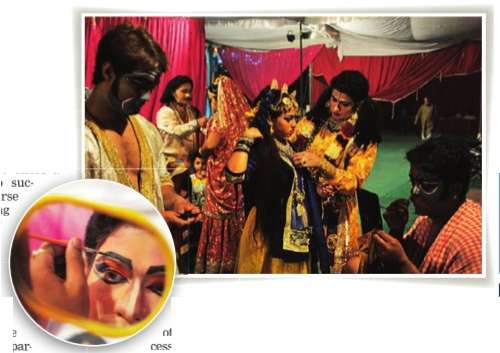Aishbagh
(Created page with "{| class="wikitable" |- |colspan="0"|<div style="font-size:100%"> This is a collection of articles archived for the excellence of their content.<br/> </div> |} [[Category:Ind...") |
Revision as of 20:56, 15 October 2016
This is a collection of articles archived for the excellence of their content. |
The Ramleela of Aishbagh
The nawabs conceived a mantra of harmony ages ago. They blended diverse cultures into a fabric woven with love and respect. The formula of harmony is what India needs today
The present-day Ramlila maidan in Aishbagh is actually one of the vertices of a triangle of communal harmony, conceptualised in the era of nawabs of Avadh. Social anthropologist Prof Nadeem Hasnain, who has prepared an ethnographic portrait of the city, has noted that this Ramlila Maidan is one of three pillars of a sacred com plex visualised by the nawabs.
Aishbagh Eidgah (where Sunni Muslims offer namaz in larg est number) and Karbala Malka Jahan (where Shia Muslims ob serve Muhar ram rituals) are the other two.The place offers a “The place offers a constructive mantra to successfully rule a diverse population something which all present day politicians can lear and which the country des perately needs as of now,“ said Hasnain, adding, “The nawabs created a relationship of dependence which paved way for par ticipation of one community in the events of others'. They also made Hindu-Muslims live like neighbours--Hus sainabad is right beside Ramnagar. Hindus mourn ing, making tazias or observ ing maatam in Muharram and Muslims contributing their skills to conduct of Ramlila in Aish bagh are all proof of that mantra's suc cess.“
He added that the nawabs personally contributed towards cementing ties between the two communities. “Their gestures won over peoples' hearts and thus they reign on everyone's mind even after 160 years of the end of their rule,“said Yogesh Praveen who has authored several books on Lucknow, adding that the nawabs' formula may give an insight to PM Modi who is preparing to add the jewel of UP to his crown.“
Nawabs gave equal land for Ramli la maidan and Eidgah making us neighbours who stand by each other in good times and bad. The tradition is a part of life and we put up drinking water stalls on Eid and they (Eidgah management) contribute to our events,“ said Pandit Aditya Dwivedi, general secretary of Aishbagh Ramlila Samiti. The opening prayer in the Ramlila is choreographed by Kathak teacher Shams-ur-Rehman Naved. The craftsman making effigy of Ravana is a Muslim too. Talking to TOI, effigy maker Saqib Khan said, “No one, except for the one who plays Rama can feel my happiness to see Ravana turning into ashes.“
Ramlila troupe director Bhaskar Basu said he comes to Aishbagh because of its secular character.
The birthplace of the Ramleela?
[http://epaperbeta.timesofindia.com/Article.aspx?eid=31808&articlexml=STAGE-TO-ENACT-EPIC-11102016013029 STAGE TO ENACT EPIC, Oct 11 2016 : The Times of India (Delhi)
Aishbagh is believed to be the place where tradition of Ramlila originated. TOI traces the 400-year-old history meandering through through written texts and oral traditions
1511 1623 | TIMES OF TULSIDAS
Author of Ram Charit Manas, Goswami Tulsidas is said to have lived in Aishbagh during Chaturmasa (religious period between July and October meant for religious observances like penance, meditation, pilgrimages).
He also penned his book Vinay Patrika here and formulated narration of Ramlila with the help of sanyasis who accompanied him. He took this Ramlila model to Ayodhya, Varanasi and other places
1722 1856 | GENEROUS NAWABS
Nawab Asaf-ud-Daulah (1775-97), who made Lucknow the capital of Avadh, patronised akharas which staged Ramlila. Nawab Saadat Ali Khan (1797-1814) took part in Ramlila. The current site was given by Nawab Nasir-ud-Din Haider (1827-37 AD). Mohd Ali Shah (1837-1842) ordered that grant given for Ramlila shouldn't be stopped. Nawab Wajid Ali Shah (1847-56) followed the legacy
1857 1980 | PATRONS' RULE
After the fall of nawabs and given the role of by sanyasis in the war of 1857, the akahara came on the radar of East India Company officers and sepoys. Post-rebellion, the place was plundered by making the sanyasi look for refuge. Somehow, the mahant incharge met a business family, currently represented by Harish Agarwal, to take the responsibility. In 1860, the family formed a committee to manage the affairs which continues to function even today.
1981 onwards | PRESENT DAY
Till 1980, the committee was presided by Agarwal family. But the structure changed in 1980 after the main family couldn't carry the responsibility following untimely death of the representative member thought it was a part of the management. A constitution and rule driven system works now and manages to get sponsors for the grand show. The traditional `maidani'form of staging of Ramlila has been replaced by technology backed entertainment


